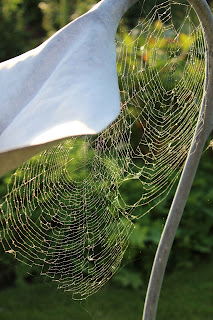I do love September.
It’s a gentle month of misty mornings, golden afternoons and dew-laced spiderwebs. Of shiny new school shoes, unsullied copybooks, the ending of fickle summer friendships and renewal of old, strong ones. It’s rich with the hedgerow bounty of blackberries and damsons, and paper bags bulging with fat seeds. It’s a month of bygones forgotten and the promise of a better future.
 More prosaically, September is the month which for me marks the move from this gardening year to the next. Yes, there’s plenty still to enjoy this year and lots that you can do to extend that enjoyment, if you want to. There will be apples and damsons to collect and I might do a bit of dead-heading and gap-filling here and there if I’m in the mood.
More prosaically, September is the month which for me marks the move from this gardening year to the next. Yes, there’s plenty still to enjoy this year and lots that you can do to extend that enjoyment, if you want to. There will be apples and damsons to collect and I might do a bit of dead-heading and gap-filling here and there if I’m in the mood. |
| Dictamnus seed pods |
There is no better way to get to know a plant than to spot it in flower, note which insects come and go and watch it closely day after day as its seed pods fatten and ripen.
A new plant has me peering at it and picking off test pods so that I can figure out when best to collect its seeds. Vitally, I want to know whether they will wait patiently until I happen to pass by, or whether I’ll have to be there on the hour, ready to pounce at the exact moment when the seeds are ripe but before the plant flicks them off into the undergrowth. With some, like the Dictamnus, I cheat the poor plant by picking the pods early, so that when they do explode they are already securely in my possession. There is no shortcut. Watching and figuring it out for yourself plant by plant is the only way to work out how best to gather your harvest.
All I wanted to say is that now is the time to stop, reflect and make a few notes. It’s the perfect time to write down which plants need moving, or where a splash of scarlet, or a vertical stripe of blue would do wonders. To sketch where a tree would add some much needed height. To pinpoint the spot where a golden, quivering grass would catch the evening sun. To note that if that low branch on a tree was removed you could see through to a favoured clump of white phlox beyond. And so on.
These things will not be obvious in November or March no matter how sure you are that you will remember. You’ll probably forget the name of that tomato variety a friend mentioned and the fact that right now you really like Heleniums. You think you’ll remember, but next spring you’ll be ogling a dainty Narcissus and wishing you’d planted a drift of them, and thoughts of late summer colour will be a misty memory.
So if you haven’t already done so much in this wet, cold summer, take a mug of tea or a glass of wine, park yourself in a chair in the garden in the September sunshine with a little notepad and do a little thinking ahead.
And a very happy gardening new year to you all.
4 Responses to “Happy New Gardening Year”
Nice post Sue. Am going to take your advice in the last paragraph. And it's misty here too, with a whole week predicted without rain.
Glad to hear it Charles. On both counts.
I have fallen out of love with gardening over the summer (August blues I think) and sitting down with a cup of tea and my notebook is just what I need to do to get back to it.
I can't imagine falling out of love with gardening. It's all the other stuff to do with running a business around it that is hard, especially being open to the public all summer and all the organising, admin and service provision that goes with it. Escaping to the garden when no-one is here is still something I still crave more of.